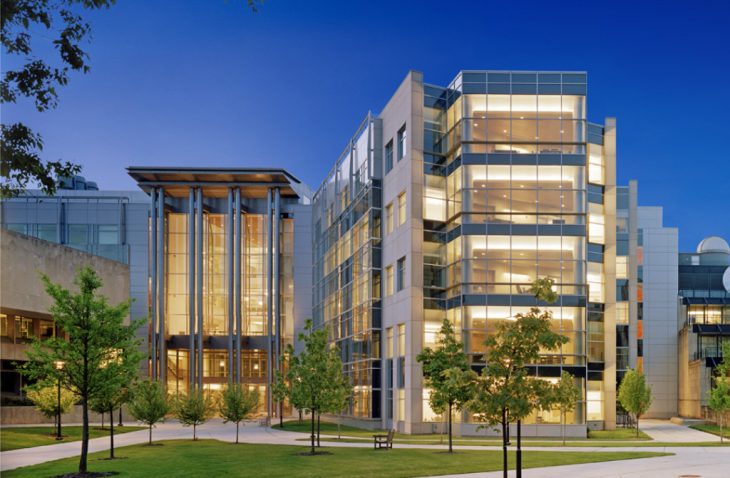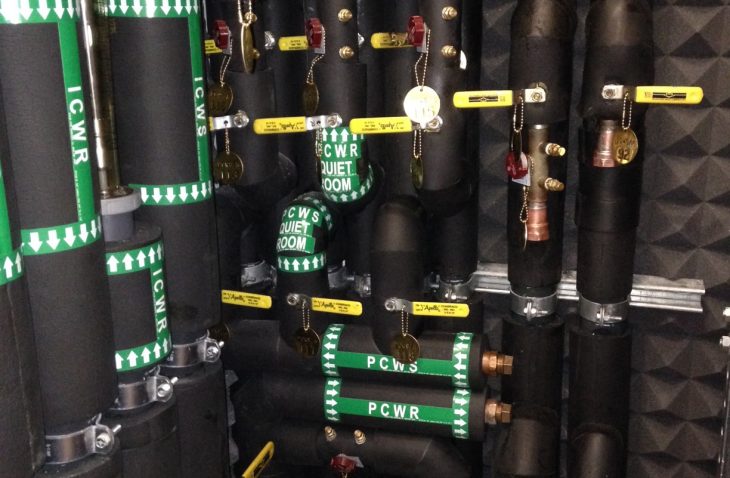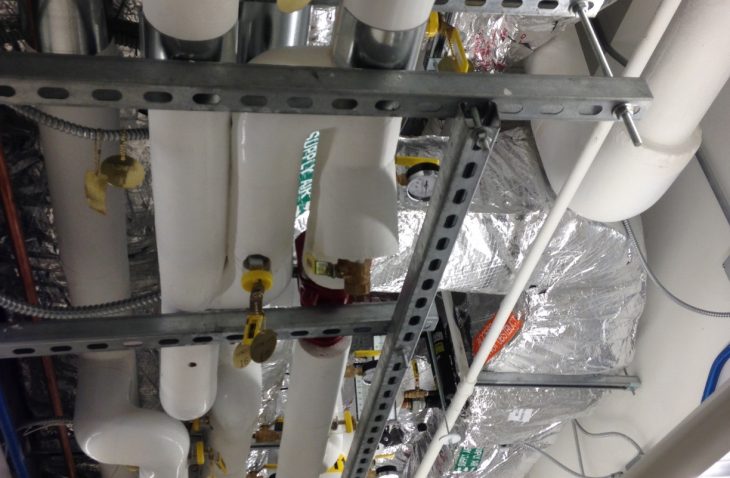New Laser Lab Suite
IMEG provided design services for this renovation which consisted of converting approximately 1,000-sf of existing electronics laboratory space into the Laser Laboratory Suite for Cheng Chin’s research in the University of Chicago’s Gordon Center for Integrative Sciences (GCIS) Building. The scope included developing bridging documents to relocate the existing space users to an adjacent building. Due to the critical vibration requirements of the research space, this project occurred on GSIC’s sub-basement floor, which is approximately 30 feet below grade. The suite consisted of three separate spaces: A work/dirty room that is used as a controlled entry into the suite from the primary corridor; a main lab (containing two laser tables) that can be sub-divided with a curtain; and a quiet room by the main lab that also contains two laser tables. The work room is used to buffer contaminants entering the laser labs and house equipment that generates noise and vibration, such as DC power supplies and laser equipment chillers.
Minimizing vibration, noise, and EMI, temperature stability of +/- 0.5°F, and overall cleanliness of the environment were imperative to the project’s success. A dedicated AHU was provided for the suite and installed in an adjacent space with vibration and acoustic isolation. The AHU contains two identically sized supply fans, each sized for the full load, providing full fan redundancy. The primary supply was sub-divided and reheat coils were provided in each branch duct to accommodate individual space temperature control. Users have access to a wall-mounted temperature sensor (designed with an enclosure containing a circulation fan to circulate air across the temperature sensor and decrease response time to changing load conditions) and a temperature sensor mounted above the laser table for temperature control of the space. All air supplied to the suite is HEPA filtered. The dedicated AHU is a recirculating unit that receives primary outside air from a building air handling system. The primary air received is controlled to maintain approximately 20 percent RH during low humidity times of the year, and therefore additional humidification was not deemed necessary. A low temperature chilled water system containing glycol was used to provide the dehumidification needed to maintain 40 percent RH maximum in the overall suite. The lab also required nitrogen, compressed air, vacuum, pure water, and instrument cooling water. These lab utilities were routed and terminated both above and below the tables. The utilities that terminate below the tables were routed through an accessible trench.
The lab required approximately 70 circuits at various ampere and voltage/phase ratings. Power was located at multiple heights on walls, at floor-level below laser tables, on racks above laser tables, and at the ceiling to accommodate all potential user needs. Circuits were derived from separate conditioned “clean” and general “dirty” sources and uniquely color-coded in the lab. Wiring was specified to be factory twisted to minimize EMI. A low-resistance grounding and bonding system was provided for the lab and included bonding of metal objects, user ground connections, and static dissipative flooring. A cable tray system was provided throughout the suite for the user’s DC power distribution and data collection cabling. Lighting was designed to illuminate laser tables while avoiding obstructions such as cable tray and overhead racks.
EMI, acoustic, and vibration testing were performed to verify that the existing environment could accommodate the program requirements. The extremely low vibration and noise requirements of the lab allow researchers to cool experiments close to absolute zero, where atoms condense into quantum BECs. IMEG worked with researchers to develop the vibration and noise criteria, test the existing vibration from various sources and plan the required control of noise and vibration for the new labs. Vibration criteria was selected to keep the heating rate below 1 nanoKelvin per second. Existing vibration was measured using
a state-of-the-art, seismic accelerometer and 24bit, 102.4kHz sampling, DSP, Dynamic Signal Analyzer.
In several instances, the testing indicated that existing vibration sources were going to exceed the program requirements. The University of Chicago decreased these sources through separate projects. Examples include isolating existing sump pump discharge piping from the sump pump and structure down the hall from the suite, as well as adding isolation to existing steam condensate return pumps located in a mechanical room above the suite.
All project deliverables were developed in BIM to coordinate the large amounts of ductwork, utilities, and suspended structural rack system that was needed to support the laser research program in the space.










